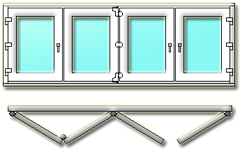Laminated Glass

Fundamentals of Laminated Glass
Laminated glass, incorporating a Poly Vinyl Butyral (PVB) interlayer between multiple glass layers, ensures structural integrity upon impact and offers exceptional protection against UV radiation, blocking 99% of harmful rays. This glass is widely acknowledged as a safety glass suitable for areas with high impact risks or potential fall hazards.
Material Composition and Usage
PVB is renowned for its robust binding capabilities and flexibility, making it ideal for applications requiring safety and clarity, such as automotive windshields and architectural glass. Brands like BUTACITE and SAFLEX are leaders in the market, offering PVB films starting at 0.38 mm thickness.
Laminated Glass Attributes
-
PVB Thickness Levels: From 0.38mm up to 1.52mm
-
Color Options: Includes clear, gray, and more vivid colors like orange and purple
-
Optical Properties: High light transmittance and low emissivity, ensuring effective thermal management
-
UV Protection: Superior UV screening, protecting against the fading of interior materials
Safety and Security Advantages
The energy-absorbing qualities of the PVB interlayer keep glass fragments together, greatly minimizing the hazard of sharp glass shards. This feature also enhances the glass's resistance to break-ins, providing continued security even when damaged.
Acoustic Performance and Solar Control
Laminated glass is highly effective in reducing noise penetration through windows and doors, offering substantial sound transmission loss. It also regulates solar heat gain, which can be optimized further with additional glass treatments, ensuring energy-efficient windows that maintain a comfortable indoor environment.
Weather Resistance and Longevity
Designed to endure harsh environmental conditions, laminated glass is a robust option for buildings in storm-prone zones, offering continued protection against high winds and rain. Its durability ensures long-lasting performance without compromising on safety or appearance.
Aesthetic and Functional Excellence
With its minimal visual distortion, laminated glass is ideally suited for architectural applications, providing sharp, clear images that enhance the aesthetic appeal of building exteriors.